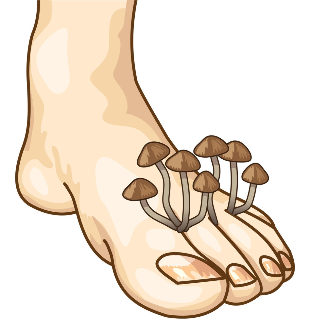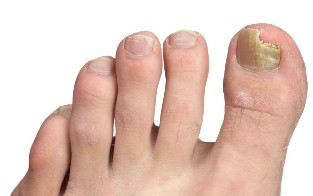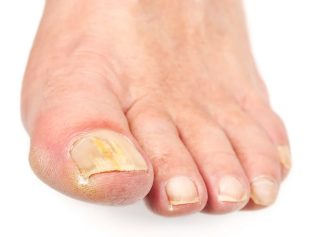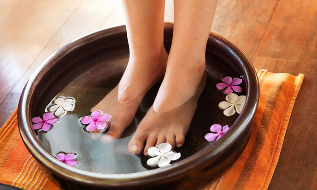Fungal infection is very commonly affects the toes or fingernails. The disease-prone adults and children. To prevent the transition of the disease into a chronic form, it is necessary to know the symptoms of fungus on your feet, and how he looks like such a disease.

The main symptoms of the disease
For all diseases of the skin mycosis of the feet is the most common. Infect diseases can be to ignore basic rules of hygiene. To cure the same fungus is sometimes very difficult.
For each man the nails of the feet begins and develops in its own way. Here are the most common symptoms by which you can recognize athlete's foot:
- between the fingers appears characteristic of the crack;
- to understand what appeared the fungus, it is possible after the reported itching on the feet and between the toes;
- skin is feet very dry, it is often the flakes and coarsens;
- between the fingers will appear blisters, which in fat they burst;
- the infection can pass to the neighboring land;
- on the skin appear reddish spots that cause considerable discomfort;
- finding the fungus on the feet, it is possible, and the nasty smell.
Signs of mold depending on the type of pathogen
This disease develops due to various kinds of pathogens. Symptoms of lesions of the legs will vary in each case.
- If the foot develops a yeast, then the nail is gradually narrowing, to exfoliate from the bed. The skin on the legs hyperemic (gets a red tint).
- In the development of fungi on nails turn yellow, is covered with patches. The skin on the feet flakes, comes out of it smell. A characteristic symptom of this type of mold – the increased dryness of the skin.
- Upon the occurrence of mold spores will be the nail plate develop a yellowish can dramatically change the color. The skin turns red, if the causative agent of the disease gradually passes on all legs. A man tormented by the itching, the skin can crack. In such a case, when walking to appear the pain and other unpleasant feelings.
Determine the type of pathogen, can only physician. In domestic conditions it is not possible. And if the practice of the self, it can only hurt. It will suffer from foot and skin fungus will spread still more.
The symptoms of some forms of mold
Depending on the affected area and the degree of development secrete several forms of pathology. The symptoms of each of them is different. Know the early symptoms of diseases of the feet, it is possible to timely start the treatment of thrush.
- Interdigital Dermatophyte — the most common phase of the disease. She is activated in the spring and in the summer, when the feet are the most sweat. Between the fingers appear out of kilter and ulcers. You will notice the availability of the scales of their skin. The foot looks perfectly healthy. Often the person feels itching.
- Erased form is manifested in at least a significant extent. Between the fingers of the noticeable flaking. In this stage of the disease at the legs spread a sharp odor: it appears as a result of increased activity of the bacteria.
The disease is able to progress in a variety of forms. Get acquainted with their symptoms, to know how to recognize the mildew on my feet and in the case of his development to begin treatment. It is necessary to remember that in more advanced stages of the disease the nail is completely destroyed. Restore it is virtually impossible.

Scaly type
For this mold characteristic of the intense exfoliation of the epidermis. While the most acutely affecting areas of the skin between the toes and on the lateral side of the foot. The symptoms of the inflammatory process is absent. On the photo the first signs of a mold of the feet are noticeable sections of the congestion. Flakes and mushroom looks as follows:
- with a thickened stratum corneum;
- the skin shimmers, sometimes it becomes a colon;
- the image on the skin becomes more distinct;
- the fungus is gradually spreading to the toes, whole foot, affects the nails;
- sometimes the epidermis appears salaries flakes;
- other discomfort the patient does not feel.
Chronic type
When this fungus on the skin appear small blisters filled with fluid. They usually come in the side of the leg. Then gradually passes to the inner side of the fingers. How to recognize athlete's foot, chronic type:
- bubbles usually unique, but if they are many, then they merge into one big;
- if left untreated, the fluid in the bubbles gradually darkens;
- if a blister bursts, then in its place appears the erosion crust.
Intertriginous type
This type of mold is the most common. Initially, a person does not feel any symptoms. To a certain point is the leather on the toes of the feet does not change. Later appear the cracks, layering. The skin is not affected, but it may sweat.
The defeat of the fungus stop
The characteristic symptoms of this fungal lesions of the the following:
- the lesion — it is a 3. or 4. finger of the foot;
- the skin is red and swollen;
- around the fireplace with lesions located bubbles, where is the exfoliated layer of the skin;
- property location located in blisters, bubbles.
Symptoms of fungal lesions of the nail
The person may become, and the nails of the feet. Distinguish disease is possible by the following symptoms.
- Expressed as a change in the color of the plate of the nail. Depending on what type of pathology is available for the patient, the nails will acquire a variety of shades. Sometimes it can change only on the part of the nail plate.
- Crumbling of the nail. This happens only in the more advanced stages. If you have your nails completely attacked, he is destroyed.
- Change the structure of the nail.
There are several different varieties of onichamykóza — fungal lesions of the nail.
- Atrophic appearance. Board nails looks very thin. It darkens, sometimes acquires a grayish-brown color. The nail gradually separates from its bed. The skin under it becomes rough and loose.
- When normotroficheskie the form mold foot board to change its shade. They appear spots of white, yellow, green and even black color. The structure of the nail does not suffer.
- In the hypertrophic form of a plate gradually thickens, becomes porous. The affected area is very unappetizing looks and in many cases is the cause of the painful feelings during the walk. On the sides is falling apart, and without treatment it is destroyed.

Some varieties onichamykóza
Depending on the extent of the spread of the disease posing as its forms.
- Lateral onychomycosis is the most common. On the free edge of the nail appears first small yellow spots. Furthermore, it is possible to observe, how it grows, and plate the nail thickens. During walking a person feels discomfort. Noticeably the spread of odors. Lateral onychomycosis is difficult to treat.
- Superficial onychomycosis is a common defeat only the top layer of the board. She thicken, but over time, it becomes like chalk.
- The most rare form of the disease is subungual onychomycosis. The skin is visibly thickens in the nail fold. The nail white and loses its transparency.
Group risk
In fact, the "pick up" the sponge, you run the risk anywhere — even at home. But in public places, of course, the chance is much more (if not adhere to the caution).
Who is at risk?
More than just a catch fungus threatens people with the following diseases:
- Flat feet and deformation of the feet.
- Broken blood circulation.
- Excessive sweating of the feet. Often the sponge to "stick" athletes and soldiers, who in the validity of the specifics of the job they must walk in tight or uncomfortable shoes even in the heat.
- The availability of corns on the stop, and also people with coarse and thick skin on the feet.
- Of low immunity.
- The presence of chronic diseases.
- Frequent injuries of the skin around the nail either the nail plate. In this category it is possible to include lovers pedicure in salons, or people, neglect the rules of hygiene.
- Diabetes.
General principles of treatment
Any treatment of the pathology starts with the diagnosis. Only then should set apart a suitable tool. Self usually leads to a deterioration of the condition of the feet. Get acquainted with the most common methods of therapy.
- At the first signs of the fungal lesions use special varnishes, plasters, ointments, sprays. You need to use them for a long time and according to the instructions.
- Upon failure of the local therapy of prescribe anti-fungal medication of the integrated action. It is used orally.
- Surgical removal of the affected nail.
- Laser.
- When running forms of the disease prescribe systemic medications.
Prevent the occurrence of unpleasant diseases it is possible, observe the rules of hygiene. It is necessary to avoid the use of foreign means of personal hygiene (towel, slippers). Upon the occurrence of the first symptoms of the disease it is necessary to immediately consult your doctor.
The 10 best folk remedies for nail fungus

In the presence of suspected nail fungus, at the same time with treatment by a specialist, you can use, and one of the folk methods. It is not recommended to perform to its place of treatment to the doctor— you risk to aggravate the problem, and then the healing process will be really long and exhausting.
So, what tools to us from our grandmothers and grandparents?
- Regular nail treatment in one of the following tools: tincture of propolis, the antiseptic tea tree oil, apple cider vinegar.
- Baths for the feet.For them you can use sea salt (preferably without additives), the infusion of celandine, yarrow, st. john's wort, oak bark, chamomile, calendula, etc. After the trays need to lubricate the nails lemon juice, iodine or apple cider vinegar.
- Iodine. The essence of the treatment: twice a day apply on damaged nails (20 days) 1-2 drops of iodine. When successful, treatment further let's move on to the processing of 1 times in 3 days.
- Kombucha. Its extracts are used as poultices. Enough to impregnate the gauze, put a bandage and leave over night under a polyethylene and socks. It is also possible to use directly a part of the tea fungus on the nails, after which it is necessary to wrap and leave for a couple of hours. After — on a pair of legs and put a mixture of apple cider vinegar (1 piece), alcohol 96% (2 parts), glycerin (2 parts). Leave it over night. The course of treatment — 2 weeks.
- The garlic oil.Pour rubbed with garlic hot sunflower oil until complete coverage of garlic. All the mix, tightly closed, and insist 2 days. The essence of the treatment: wetted swab in the oil, apply to the patient land, store, bandage, protecting top of polyethylene, put on socks and leave for the night. Course — 2 weeks.
- Vinegar.Wetted swab in vinegar (9%), apply on the damaged stretch, wrap polyethylene, fix the patch and leave for the night. Morning all, once again we repeat.
- Soda with celandine. Up your feet in a solution (3 liters of water + 1 art/l soda), wipe your feet, lubricates the diseased part together with your fingers the oil of celandine (look for at the pharmacy). Course — 2 weeks.
- Birch tar. Up the legs using the household/soaps (about 20 min), cleanup of the soles of the feet with a pumice stone, cut nails, dry wipe the legs and lubricates the nail with the fingers of birch tar. They put feet on the paper for 1.5 hours and read a book. To further remove the excess tar bandage, put on a x/b socks and we forget, when the legs for a few days. After the expiry of my feet again with the home/and soap in lukewarm water. Evening repeat the procedure. Course — 2 weeks.
- Kalanchoe. Treatment: on unpainted nails adhesive using a patch of the leaves of kalanchoe so as to cover them together with the holes the nails. Patch with listikami is changing every day. Course — 2-3 weeks.
Measures for the prevention of nail fungus
Protect yourself from mold can easily compliance with the rules of hygiene, and timely preventive measures.
Remember:

- In all public places (beach, showers, locker rooms, pool, spas, salons, etc.) we put easily washable slippers. Do not walk barefoot where there is a risk to pick up any infection!
- Not to put on one's shoes (including the shower away — it is better to look like in socks).
- They are not strangers towels and nail needs.
- He gets up from the tub, put my feet on the overall (and often they are wet, not the first freshness) the pad, and its the same towel (pre-mark it under such targets).
- Regularly check the feet and nails on the topic of the emergence of signs of mold. At the slightest symptoms (appeared to diverge/itching between the fingers, changed the color on the nails, etc.) to take action. This means that the buy ointment, specials/varnishes etc.
- Try not to use tight, narrow shoes as well as boots from low-quality materials.
- We periodically evaluate the your shoes from the inside with antiseptics.
- To feet are not sweating, use deodorants, talc, etc.
- We only use x/b socks. When you need to use pantyhose/tights (apparel of nylon and other synthetic fabrics), home necessarily to shoot, up the legs, we evaluate.
- In the heat we wear open shoes — for ventilation and free air. Sweaty feet — the soil for the growth of bacteria.
- Not measure the shoes in the store without socks/feet— on bare feet.
- Dry wipe the feet after the bathroom, including the gaps between the fingers — it was from there begins a sponge.
- Not allowed cracks on the feet — use a moisturizer.
- The legs of my antibacterial soap.
- At high risk of infection (e.g. on holiday or in the pool) we apply the antifungal cream, powder or spray.
- Thoroughly dry the shoes, if wet. No, no our wet shoes/boots.
- Choose exclusively the best salons for the procedure of pedicure/manicure.
- Not allowed ingrown and deformation of the nails — take action in a timely manner.





























